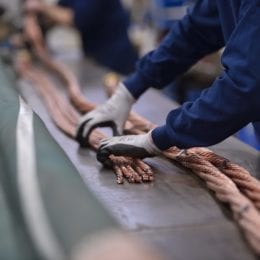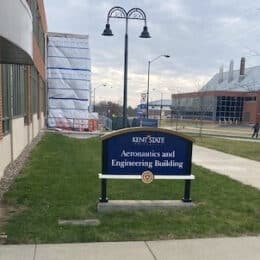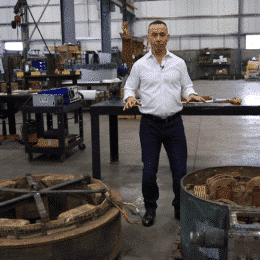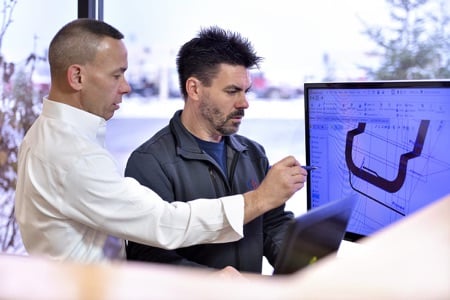Electrical & Metal Processing Glossary
Definitions & terms commonly used in industrial power transmission
- A -
Air-cooled power cables – or dry jumpers, leads or cables, are high current power cables designed to use non-insulated copper wire. Air-cooled power cables are ideal for applications requiring increased flexibility including resistance welding, resistance heating, and bus bar systems.
Alternate polarity cable – Commonly referred to as kickless, this type of cable features low inductive reactance where positive and negative conductor wire is positioned alternately throughout the cable.
Ampere – or commonly known as amp, is a measurable unit of electrical current (I) equal to a flow of one coulomb per second. Amps measure the electromagnetic force between electrical conductors carrying electric current.
- B -
Bus Bar or Bus Tube Systems – conduct high current electricity within a rigid switchboard, a substation or a battery bank, transmitting substantial power from the source to the load. Usually made of rigid copper, brass or aluminum, bus systems both ground and conduct electricity.
Bulkhead assemblies – Rigid bulkhead assemblies make feeding multiple power cables through differing environments easier to access for maintenance and servicing. Cables are connected to rigid connections on both sides of the bulkhead separating environments.
- C -
Coaxial cable – is used in metals processing and consists of two concentric conductors, inner and outer, separated by an insulator spacer.
Conductor – is the bare wire or metal used to convey electric current from the source to the load. A conductor can be copper, brass or aluminum.
Coreless induction melting – In a non-contact method to melt/heat metals, or other conductive materials, an electromagnetic field is generated within wound copper coil to create stirring action.
Current – Measured in amperes, current (I) is a flow of electric charge often carried by moving electrons in a wire. Knowing how much current is flowing to your load is very important in selecting the correct wire. Electric currents create magnetic fields.
- D -
Dielectric insulation – material which has energy storage properties, typically by means of polarization.
Dry jumpers or dry leads – are high current air-cooled power cables using non-insulated wire to transmit power from the source to the load.
- E -
Electric arc furnace (EAF) –melting utilizes three graphite spikes, or electrodes, powered by high-voltage electric currents. Direct and radiant heat melts metal, ore, flux and solid fuel.
Electron beam (EB) melting – typically occurs in a vacuum-sealed furnace using a high-voltage electron beam to deliver heat to pure metals and alloys in a consumable electrode form.
Electroslag remelting (ESR) – uses a highly reactive slag layer powered by electric current to clean molten metal of impurities.
Electromagnetic stirring (EMS) – Electromagnetic, or induction, stirring improves the homogeneity of molten and cast metal. In continuous casting applications, high-current stirring units are placed adjacent or within to the extrusion line to produce an electromagnetic field forcing continued stirring action within the cast product such as billets, blooms and slab. In electromagnetic ladle stirring, the action is the same whereby molten metal is stirred by an adjacent ladle EMS unit inducing electromagnetic flow patterns. The EMS device improves homogeneity post melt and allows timely in-ladle alloy additions.
- I -
I2r – is a formula for electrical efficiency. Power loss is caused by the flow of current through a resistance. I2r power loss, or undesirable transfer of energy, in an electrical device is caused by the flow of current (I) through a resistance (R) that requires power consumption twice/or squared the power.
Induction – is the heating or melting of metals and material by inducing a high-current powered electromagnetic field to create stirring action without contact.
- J -
Jumpers - power jumpers are high-current power cables, also called leads, used to transmit power from the source to the load.
- K -
Kickless cable – is an alternate polarity power cable featuring low inductive reactance where positive and negative conductor wire is positioned alternately throughout the cable.
- L -
Leads – power leads are high-current power cables, also called jumpers, used to transmit power from the source to the load.
- O -
Ohm – is a standard unit used to measure electric resistance (R). Georg Ohm defined 1 ohm as the resistance between two points in a conductor where the application of 1 volt will push 1 ampere, or 6.241 × 1018 electrons. This value is usually represented in schematics with the greek letter Ω, called omega.
Ohm’s Law – Georg Ohm’s formula is V = I x R. V is the voltage measured in volts, I is the current flowing through the wire measured in amperes, and R is the resistance of the wire measured in ohms.
- P -
Pass through assemblies – also called feed through assemblies, are rigid fabrications allowing substances or energy to pass through differing environments and remain leak-tight.
Plasma arc remelting (PAM) – is an electrical operation utilizing an ionized gas plasma flow, typically created by an electric arc heater, to heat, melt and refine metal alloys.
Power – Electrical power in any part of a circuit is measured in watts (W). A watt is the power used when one volt causes one ampere to flow in circuit. In an electrical system, power (P) or watts (W) is equal to the voltage (V) multiplied by amperes or current (I).
- R -
Resistance – (R) is a material’s tendency to resist the flow of electron charge or current (I) due to conductor material, size or design.
Resistance welding - is the joining of metals by applying pressure and directly passing electrical current for a length of time through the metal area which is to be joined. No other materials are needed to create the bond.
Resistance heating - As electric current passes through the material to be heated ohmic losses, or I2R losses, occur. These losses cause the conversion of electrical energy into heat. In direct electric resistance heating, the current is passed directly through the material that has to be heated, for example, resistance welding. In indirect electric resistance heating, the current is passed through a highly resistive material placed inside an oven, such as for domestic cooking, room heaters, etc.
Rope lays
- Regular lay denotes wire rope in which the wires are twisted in one direction, and the strands in the opposite direction to form the rope.
- Lang lay denotes rope in which the wires and strands spiral in the same direction and appear to run at a diagonal to the center line of the rope. Due to the longer length of exposed outer wires, lang lay ropes have greater flexibility and abrasion resistance than do regular lay ropes.
- Right or left lay refers to the direction in which the strands rotate around the wire rope. If the strands rotate around the rope in a clockwise direction, the rope is said to be right lay. When the strands rotate in a counterclockwise direction, the rope is left lay.
- S -
Secondary conductor – is the high-current flexible power cable, also called jumper or lead, or rigid bus system used to transmit power from the source to the lead.
Submerged arc furnace (SAF) – like electric arc furnaces, SAF melting utilizes three graphite spikes, or electrodes, powered by high-voltage electric currents. SAF electrodes are submerged deep in the furnace load to melt directly and with radiant heat.
- T -
Thermal processing – of metals improve material properties such as strength, durability and corrosion resistance. Processes include heat treatment and metal joining, hot isostatic pressing (HIP), sintering and other surface applications.
- V -
Vacuum arc remelting (VAR) – is an induction melting process under vacuum. Using the alloy to be remelted and refined as the electrode, high current is applied to electrically arc with a small amount of the same alloy at the bottom of a deep crucible. Once the arc is started between the two, the continuous melting process begins.
Vacuum induction melting (VIM) – uses high current electricity within a vacuum to melt metal. In this non-contact method, an electromagnetic field is induced and heat is created.
Voltage – (V) is the amount of potential energy, or electromotive force, between two points on a circuit. One point has more charge than another. The difference in charge is called voltage. Voltage is the available energy or electron charge which drives current (I).
Voltage loss – occurs when current flows across conductor resistance and is influenced by the wire diameter, length and material. Voltage loss is calculated using Ohm’s Law.
- W -
Water-cooled – a fluid circulation system used to lower the temperatures of high current power cables, electrical and melting equipment.
Watt – A watt (W) is the power, or the rate at which current flows, when one volt causes one ampere to flow in a circuit. Electrical power is measured in watts. Power (watts) = volts x amperes.
Watt loss – is created by the resistance (R) of the conductor to the flow of electrons or current (I); The rate at which energy flows, or watt loss, can be influenced by adjustments to the resistance of the conductor material, size or design.

Resources
swtc.edu
afsinc.org
atlasfdry.com
themetalcasting.com
metalsupermarkets.com
aws.org
chegg.com
paigewire.com
science.howstuffworks.com
learn.sparkfun.com
paigewire.com
assemblyspecialty.com
Additional resource provided by Girl Scouts of Southern Alabama






